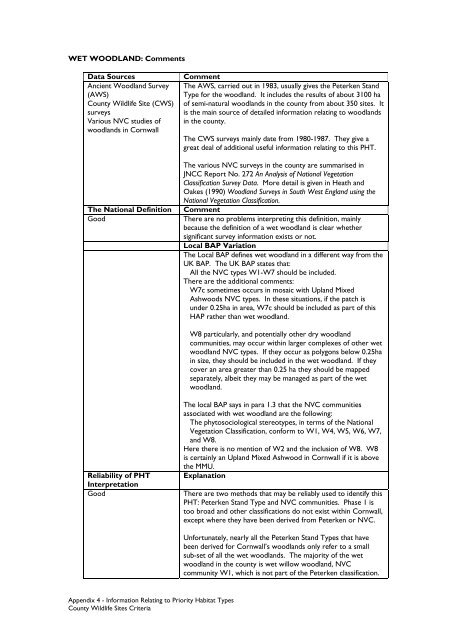County Wildife Site Criteria for Cornwall Appendices
County Wildife Site Criteria for Cornwall Appendices
County Wildife Site Criteria for Cornwall Appendices
Create successful ePaper yourself
Turn your PDF publications into a flip-book with our unique Google optimized e-Paper software.
WET WOODLAND: CommentsData SourcesAncient Woodland Survey(AWS)<strong>County</strong> Wildlife <strong>Site</strong> (CWS)surveysVarious NVC studies ofwoodlands in <strong>Cornwall</strong>The National DefinitionGoodCommentThe AWS, carried out in 1983, usually gives the Peterken StandType <strong>for</strong> the woodland. It includes the results of about 3100 haof semi-natural woodlands in the county from about 350 sites. Itis the main source of detailed in<strong>for</strong>mation relating to woodlandsin the county.The CWS surveys mainly date from 1980-1987. They give agreat deal of additional useful in<strong>for</strong>mation relating to this PHT.The various NVC surveys in the county are summarised inJNCC Report No. 272 An Analysis of National VegetationClassification Survey Data. More detail is given in Heath andOakes (1990) Woodland Surveys in South West England using theNational Vegetation Classification.CommentThere are no problems interpreting this definition, mainlybecause the definition of a wet woodland is clear whethersignificant survey in<strong>for</strong>mation exists or not.Local BAP VariationThe Local BAP defines wet woodland in a different way from theUK BAP. The UK BAP states that:All the NVC types W1-W7 should be included.There are the additional comments:W7c sometimes occurs in mosaic with Upland MixedAshwoods NVC types. In these situations, if the patch isunder 0.25ha in area, W7c should be included as part of thisHAP rather than wet woodland.W8 particularly, and potentially other dry woodlandcommunities, may occur within larger complexes of other wetwoodland NVC types. If they occur as polygons below 0.25hain size, they should be included in the wet woodland. If theycover an area greater than 0.25 ha they should be mappedseparately, albeit they may be managed as part of the wetwoodland.Reliability of PHTInterpretationGoodThe local BAP says in para 1.3 that the NVC communitiesassociated with wet woodland are the following:The phytosociological stereotypes, in terms of the NationalVegetation Classification, con<strong>for</strong>m to W1, W4, W5, W6, W7,and W8.Here there is no mention of W2 and the inclusion of W8. W8is certainly an Upland Mixed Ashwood in <strong>Cornwall</strong> if it is abovethe MMU.ExplanationThere are two methods that may be reliably used to identify thisPHT: Peterken Stand Type and NVC communities. Phase 1 istoo broad and other classifications do not exist within <strong>Cornwall</strong>,except where they have been derived from Peterken or NVC.Un<strong>for</strong>tunately, nearly all the Peterken Stand Types that havebeen derived <strong>for</strong> <strong>Cornwall</strong>’s woodlands only refer to a smallsub-set of all the wet woodlands. The majority of the wetwoodland in the county is wet willow woodland, NVCcommunity W1, which is not part of the Peterken classification.Appendix 4 - In<strong>for</strong>mation Relating to Priority Habitat Types<strong>County</strong> Wildlife <strong>Site</strong>s <strong>Criteria</strong>
















